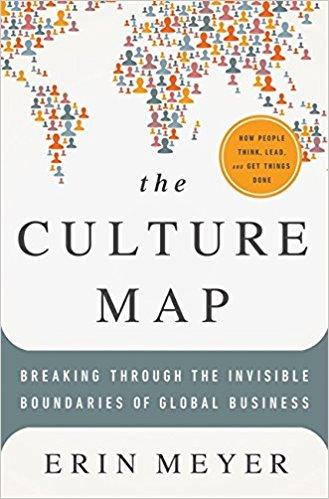The Culture Map
7 min read ⌚
 Breaking Through the Invisible Boundaries of Global Business: How People Think, Lead, and Get Things Done
Breaking Through the Invisible Boundaries of Global Business: How People Think, Lead, and Get Things Done
Some time ago, business went global.
Culture, however, didn’t.
Erin Meyer’ “The Culture Map” is your guide to effortlessly transcend the cultural barriers and acquire the much-needed skills to “decode cultures foreign to your own.”
Who Should Read “The Culture Map”? And Why?
It’s only common knowledge that cultures significantly differ from each other and what’s complimentary or conventional in one may be rude and eccentric in another.
If you are a business executive, failing to address this issue may cost you deals worth millions of dollars.
However, even though “The Culture Map” is explicitly written for leaders of international teams who want to rise above cultural clashes in the workplace, Erin Meyer’s exceptional book may help anyone who wants to improve his or her communication skills as well.
 About Erin Meyer
About Erin Meyer
Erin Meyer is a Minnesota-born American author and a professor of Cross-Cultural Management at INSEAD in Paris, where she currently lives with her husband and two sons.
She developed her interest in cultural differences while volunteering for Peace Corps in Botswana. Before moving to Paris, Meyer also worked at McKesson, HBOC, and Aperian Global.
In 2013 “Business Inc.” selected her as one of the ten best business school professors worldwide. “The Culture Map” – her only book so far – was published the following year and was met with wide critical acclaim.
In 2017, Meyer was selected as one of the most influential thinkers worldwide by both “Thinkers50” and “HR Magazine.”
Book Summary
At the heart of Erin Meyer’s exceptional book, “The Culture Map,” is an “eight-scale model” that should help managers and leaders of culturally diverse teams improve their effectiveness by offering them a platform to analyze the positioning of one culture relative to another and, thus, correctly decode the meaning of some actions and gestures.
The eight scales in question – and the two extremes between which Erin Meyer scatters many of the world’s countries – are the following:
- Communicating: low-context vs. high-context
• Evaluating: direct negative feedback vs. indirect negative feedback
• Persuading: principles-first vs. applications-first
• Leading: egalitarian vs. hierarchical
• Deciding: consensual vs. top-down
• Trusting: task-based vs. relationship-based
• Disagreeing: confrontational vs. avoids confrontation
• Scheduling: linear-time vs. flexible-time
Meyer dedicates a chapter to each of these eight areas.
And so should we a key lesson – each one borrowing the title of the relevant chapter!
Key Lessons from “The Culture Map”
1. Listening to the Air: Communicating Across Cultures
2. The Many Faces of Polite: Evaluating Performance and Providing Negative Feedback
3. Why Versus How: The Art of Persuasion in a Multicultural World
4. How Much Respect Do You Want? Leadership, Hierarchy, and Power
5. Big D or Little d: Who Decides, and How?
6. The Head or the Heart: Two Types of Trust and How They Grow
7. The Needle, Not the Knife: Disagreeing Productively
8. How Late Is Late? Scheduling and Cross-Cultural Perceptions of Time
Listening to the Air: Communicating Across Cultures
Communication is a complex thing.
Just listen to a British comedian comparing American and British movies, or an American comparing the humor of both countries.
According to Erin Meyer, the reason why Americans have trouble understanding British humor and the British consider American humor all but stupid is fairly simple.
Namely, the US is a low-context country (in fact, the lowest one), and the UK is a middle-context nation. In other words, Americans say everything they mean, and the British leave some of it to the context.
Japan is on the other side of the spectrum: it’s the highest-context country, closely followed by other East Asian nations, such as Korea, China, and Indonesia.
In their cases, most of the communication is implicit.
The Many Faces of Polite: Evaluating Performance and Providing Negative Feedback
If you’ve happened upon the Anglo-Dutch translation guide so far, you probably know that what the Dutch hear when the British say “That is an original point of view” is “They like my idea!” even though what the British actually mean is “Your idea is stupid!”
This is because different nations evaluate differently – anywhere from giving direct to indirect negative feedback.
Interestingly enough, the evaluation scale doesn’t coincide with the communication scale, i.e., some nations (such as Israel) may be high-context (implicit) nations but still give direct negative feedback – in fact, “the directest.”
You’ll get direct negative feedback in Russia and Germany too, but the Americans, just like the British, will sugarcoat it.
There’s a high chance you won’t even know what kind of feedback you’ve gotten from a Japanese executive since Japan is not only the highest-context country but also the least direct one in giving negative feedback.
Why Versus How: The Art of Persuasion in a Multicultural World
Persuasion is an art – but what kind of art depends on the country you’re in.
In fact, Erin Meyer says that there’s so much difference between Asian countries and European-influenced cultures, that “an entirely different frame of reference, unrelated to the Persuading scale, comes into play” when we’re talking about Asia.
In a nutshell, Asian countries are more holistic and want to know how things connect with the environment (the big picture), while Western countries are more specific and react better to detailed instructions.
Within the latter, old countries such as Italy and France are why-oriented (principles-first), and the newest countries (US, Canada, Australia) are more concerned with the how’s (application-first).
(And Simon Sinek is interested in both!)
How Much Respect Do You Want? Leadership, Hierarchy, and Power
While analyzing 100,000 management surveys at IBM in the 1970s, Geert Hofstede, the most famous cross-cultural researcher in history, developed the concept of “power distance,” i.e.,
the extent to which the less powerful members of organizations accept and expect that power is distributed unequally.
However, ask a Scandinavian what “a power distance” is, and he’ll probably laugh the subject right off the table: for the Danish, the Norwegian, and the Swedish “the best boss is a facilitator among equals” and “organizational structures are flat.”
Unlike the egalitarian North, the East is strictly hierarchical: in Japan, it will be a mindless act to disagree with your superior.
Big D or Little d: Who Decides, and How?
Expectedly, egalitarian cultures usually make important decisions consensually and respect the opinion of every member in the group; however, so do the hierarchical Japanese, who actually rank highest at one end of the deciding spectrum, since their directorial boards are flat structures.
Their nearest neighbor, China, is on the other end of the spectrum, just second to Nigeria in terms of top-down decisions.
There – as well as in India and Russia – decisions are made by individuals, and the others simply follow.
The Head or the Heart: Two Types of Trust and How They Grow
There are two types of trust: cognitive and affective.
Cognitive trust stems from knowledge: you know that someone is capable of doing a job based on his previous record. Affective trust has a lot more to do with the future: you expect someone to do a good job, merely because you’re close to him and her, and you believe that, for personal reasons, he/she will not disappoint you.
Cognitive trust is task-based, and if you are an American, you know what it means: business is business. Affective trust is relationship-based and is shared through meals and drinks over the long term in Nigeria, Saudi Arabia, India, and China.
The Needle, Not the Knife: Disagreeing Productively
The art of disagreement may be dying – or, who knows, it may have just taken a different form!
Because, historically and traditionally, nations disagree differently.
In Israel and France – and to a lesser extent in Germany and Russia – you are expected to get confrontational, and this will not impact the relationship in any negative way.
However, you are better off avoiding confrontation altogether in East Asian countries, since it is harshly frowned upon.
How Late Is Late? Scheduling and Cross-Cultural Perceptions of Time
You can be on time if you live in Switzerland, Germany, and Japan – countries that respect the idea of linear time and believe in sequential steps, promptness, and strict adherence to deadlines.
However, that’s not the case with Saudi Arabia, Nigeria, Kenya, and India, where adaptability is much more important and time is flexible.
In other words, as strange as it may sound to you, if you are a German in Nigeria, your Nigerian friend isn’t wrong if he/she comes 32 minutes after the agreed time.
You are wrong to have expected him/her to come on time.
Conclusion
In a world as interconnected and diverse as ours, understanding cultural nuances isn’t just a matter of etiquette; it’s a critical skill for effective communication and collaboration.
Erin Meyer’s insightful delineation of the “eight-scale model” in “The Culture Map” offers a roadmap for navigating these complexities.
From deciphering communication styles to negotiating power dynamics, each chapter underscores the importance of contextual awareness in building productive relationships across cultures.
As global interactions become increasingly prevalent, embracing these key lessons isn’t just an option; it’s imperative for success in our multicultural landscape.
Meyer’s work stands as a testament to the transformative power of cultural intelligence in fostering mutual understanding and synergy amidst diversity. In a world where differences often divide, “The Culture Map” illuminates a path toward unity through comprehension and respect.
Like this summary? We’d like to invite you to download our free 12 min app, for more amazing summaries and audiobooks.
“The Culture Map Summary Quotes”
Unless we know how to… avoid easy-to-fall-into cultural traps, we are easy prey to misunderstanding, needless conflict, and ultimate failure. Share on X
The vast majority of managers who conduct business internationally have little understanding about how culture is impacting their work. Share on X
Just as fish don’t know they’re in water, people often find it difficult to see and recognize their own culture until they start comparing it with others. Share on X
If you don’t know what your behaviors signify, you’ll have no control over the signals you send, and the results can be disastrous. Share on X
When in doubt, the best strategy may be to simply let the other person lead. Share on X
Our Critical Review
“The Culture Map” is a unique book – so it’s unsurprising that it was met with positive reviews from the public and professional reviewers alike.
In fact, according to “The Huffington Post,” “whether you’re a corporate or traditional diplomat, global traveler, government official, or passionate world citizen, this is the one book you should not miss.”
“Inc.” called it “superb,” and we share the magazine’s opinion. And that’s even though we are not leaders of an international team or CEOs of a multinational conglomerate.
But thanks to Meyer – now we can travel much more safely and relaxed!
Emir is the Head of Marketing at 12min. In his spare time, he loves to meditate and play soccer.


 Breaking Through the Invisible Boundaries of Global Business: How People Think, Lead, and Get Things Done
Breaking Through the Invisible Boundaries of Global Business: How People Think, Lead, and Get Things Done  About Erin Meyer
About Erin Meyer




